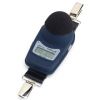The Differences Between Sound Level Meters and Noise Dosimeters
Whether in the workplace or in residential areas, noise can be a nuisance. Before rectifying a noise situation, you must first determine what kind of noise you have, who the noise is affecting, and the type of data you need to make the correction.
Your first step, then, is choosing the right type of instrument to measure noise. Typically, you can choose from either a sound level meter or a noise dosimeter. What are the differences?
Sound Level Meters give you quick glimpses into a problem area
A Sound Level Meter (SLM) is the basic, hand-held instrument used to measure general area noise levels. You can use them to spot check noises such as hums, noises from industrial machinery or equipment (i.e. large trucks, jackhammers), or noise across boundaries, such as noise from a construction site or your loud neighbors – whether they’re a truck stop or a train station that lets its trains idle during the wee morning hours. When residential/commercial noise compliance is crucial you must have the proper tools for the job.
The difference between a Type 1 and Type 2 SLM is simply accuracy. According to OSHA, a Type 2 SLM is the minimum requirement for measuring noise and is suitable for general purpose noise measurements. If precision measurements are required, a Type 1 SLM is recommended (Suggestion: CEL-633).
Use a Type 2 SLM to determine your place of action if the noise problem is isolated to one specific area, for example a booth or work station when operating a particular machine (Suggestion: CEL-246).
Another type of measurement analysis performed using properly equipped SLMs is octave band and/or third octave band analysis. This allows the user to perform a frequecy based analysis across a series of bands that are defined at the hertz (Hz) and kilohertz (kHz) levels (Suggestion: CEL-633).
Personal noise dosimeters log decibel readings
If you have situations where the noise is periodic or inconsistent – and you need data that shows the decibel readings for a period of time – then you’ll want to use a noise dosimeter.
Noise dosimeters are often used with Type 1 SLMs if noise affects multiple areas or an entire facility.
Individuals can wear noise dosimeters to determine their exposure to noise during a work shift or as they move from work area to work area throughout a facility. The instruments can also be left in an area of concern to record noise over a specific period of time.
Using the dosimeter’s software, you can determine time weighted averages as well as manipulate graphs and view data specific to individuals or areas (Suggestion: CEL-350)
Once you have the data, you can then consult OSHA guidelines for the type of protection needed to ensure you are meeting the requirements for hearing conservation.
If you need noise data for litigation purposes, it’s recommended you use a Type 1 SLM coupled with the data from noise dosimeters to prove your case.
Noise instrumentation must be calibrated annually
Whether you use an SLM or a dosimeter, you must ensure that your instrumentation is factory calibrated each year to current NIST standards. If you are in a litigious situation, data provided by calibrated instrumentation is an absolute must.
If you have questions about noise instrumentation, call Enviro-Equipment. We have the technical know-how to advise you on the type of instrument you need as well as a range of Type 1 and Type 2 SLMs and dosimeters – all maintained and factory calibrated.
Based on your needs and budget, we can rent or sell the instrumentation you need. Call us today at 888-274-8929
OSHA Hearing Conservation Program
OSHA requires a hearing conservation program for workplace environments where workers are exposed to high noise levels throughout their workday. Information on the OSHA hearing conservation program action levels and what the noise dosimeter readings mean can be found at the OSHA Noise Dosimeter Settings Webpage.
Please see these reference guides for more useful information:


